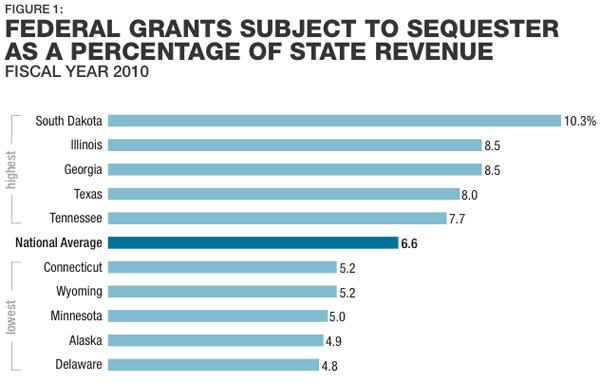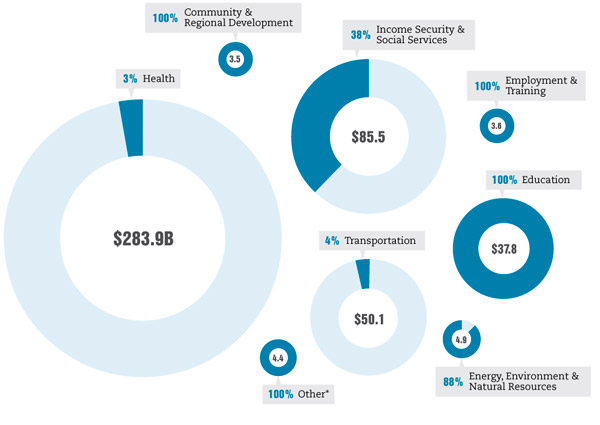
Illinois, as these things go, tends to be above average in terms of the money we collectively send to the feds (we're actually near the top), and below average in terms of the money we receive from it (we're in the bottom half). So I was a bit surprised to see how hard the sequester could hit us (via the Pew Center on the States)—though keep in mind that it represents grants that are vulnerable to the automatic sequestration cuts:

In terms of the sequestration's other effects, the state is better off: 2.5 percent of state GDP from federal spending on procurement, salaries, and wages (compared to a national average of 5.3 percent); 1.5 percent of state GDP on defense spending (compared to 3.5 percent of the average state's GDP); and so forth. The federal government just doesn't employ a ton of people in the state. In Virginia, D.C., and Maryland combined, twenty percent of their GDP is vulnerable to cuts in procurement, salaries, and wages, according to Pew's numbers.
Kevin Drum has the best short-form explainer I've read; the numbers are difficult and, despite the broadly simple concept of the sequester, tricky and malleable: "How big is the sequester? You'd think this would be an easy question to answer. In fact, it's surprisingly complicated! Are you ready?" Pew has a good one-glance look at what grants are vulnerable to the sequester, and it seems that they have an unfortunate (or not, depending on where you live) tendency to sync up with the grants that Illinois tends to receive from the federal government, particularly education and community/regional development.

For example, of the CPS budget in 2011, 24 percent of revenues come from the feds, 31 percent from the state, and 36 percent from local property taxes (PDF). In New York City, less than 10 percent is federal money. Which is why the White House's estimate for what would be the biggest direct cut to Illinois state services is education (PDF):
Illinois will lose approximately $33.4 million in funding for primary and secondary education, putting around 460 teacher and aide jobs at risk. In addition about 39,000 fewer students would be served and approximately 120 fewer schools would receive funding.
Education for Children with Disabilities: In addition, Illinois will lose approximately $24.7 million in funds for about 300 teachers, aides, and staff who help children with disabilities.
Compared to, say, law enforcement, which would see only $587,000 in cuts. Indiana, by contrast, is estimated to lose $13.8 million in primary/secondary education funding (PDF).
A lot of the sequestration cuts are going to be in nooks and crannies of the federal government, the sort of thing people don't notice until it's gone:
* A reduction in hours at O'Hare's north flight control tower and red-eye flights into Midway;
* Longer lines at TSA screenings;
* "A scheduled Blue Angels show in Rockford could be canceled";
* And across state lines, the South Shore Air Show in Gary, Indiana.
Photograph: The White House


